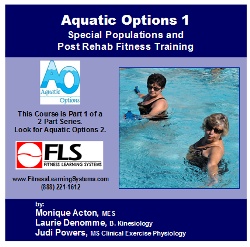Education Level: Intermediate, Advanced
Prerequisites: Basic Choreography Skills
Target Audience:
Aquatic Fitness Professional, Group Fitness, Personal Trainer
Course Description:
This course is the first module of a two-part series. Aquatic Options was specifically designed for aquatic fitness professionals, Personal Trainers, Physical Therapy Assistants, Occupational Therapy Assistants, Recreational Therapists, and any professional working with special populations and post rehab individuals in the aquatic environment.
This course will review important fitness training guidelines and help you better understand how to integrate progressive aquatic fitness exercises for shoulder, knee and hip orthopedic considerations and low back pain.
Course Objectives:
After completing this course you will:
- Learn and understand professional responsibilities associated with Standard of Care and Risk Management when working with special populations and post rehab clients.
- Identify exercise principles for cardiorespiratory, resistance, and flexibility training.
- Describe aquatic support stances for resistance and flexibility training.
- Understand the difference between open and closed chain exercises.
- Learn how to monitor intensity in the aquatic environment including an understanding of aquatic heart rate responses, objective and subjective measures of intensity, and the affects of medication on resting and exercise heart rates.
- Review shoulder, vertebral column, hip, and knee anatomy.
- Identify, list, and describe exercise goals, recommendations, movements to avoid, and specific aquatic exercises for orthopedic conditions for the shoulder, vertebral column, hip, and knee including:
- Shoulder impingement
- Rotator cuff
- Low back pain
- Sciatica
- Total hip replacement
- Total knee replacement
- Meniscal injury and patellofemoral syndrome
- Anterior cruciate ligament conditions
ISBN# 978-1-935746-18-8
Return to Product List |



